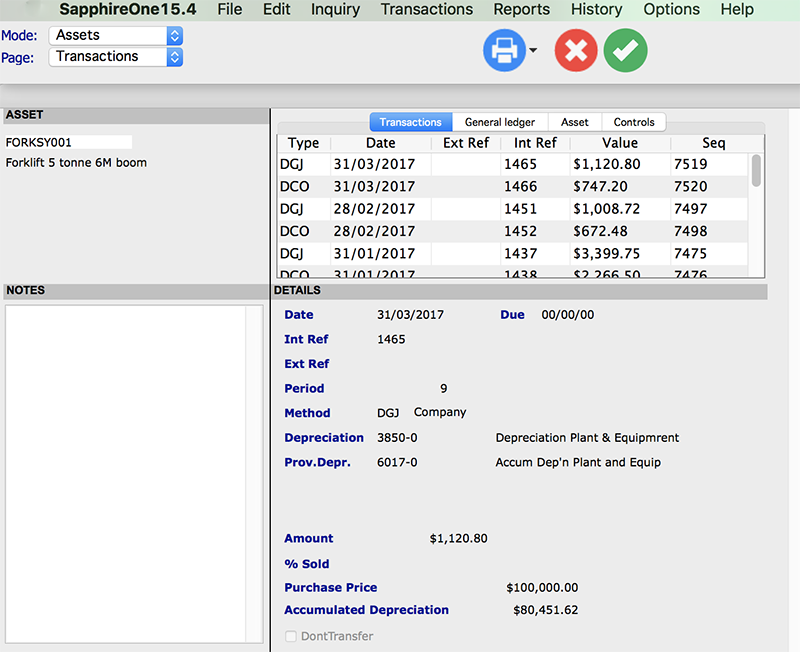Assets Software to manage your Assets Depreciations
September 9, 2020 9:51 am | by John Adams

Our Assets Software functionality is integrated into all other modes, which enables users of SapphireOne to easily keep track of its company’s assets and their depreciations.
Entering new data in the equivalent Mode of the Assets Software creates a number of transaction types that can also link through to the financials mode:
There are two groups that Transactions in our Assets Software can be divided into:
Transactions which are transferred to Financials as a GJ, VI or MP:
- DGJ – Depreciation General Journal
- PGJ – Purchase General Journal
- SGJ – Disposal Sale General Journal
- VGJ – Revaluation General Journal
- RGJ – Reverse Sale General Journal
Transactions which are retained within Assets:
- DNT – Depreciation Note
- DLN – Depreciation Loan
- DSR – Depreciation Service
- DRP – Depreciation Repair
- DCO – Depreciation Company
The Assets Software is based on two principles:
Assets Depreciations
This is the calculation of multiple depreciation schedules in relation to the company assets. Only one depreciation schedule may be transferred to the General Ledger. This covers the ATO Standard, plus the Company required value. For example: Your company may wish to retain a record of the WDV tax value, plus the potential WDV sale value. We suggest that only the transactions relating to the ATO Standard are transferred to SapphireOne, while the company transactions are kept within Assets in order to give a true reflection of the assets worth.
Asset Control
The Assets of your company can be purchased, sold and controlled with ease in SapphireOne. It includes the ability to record locations of assets and the specific staff responsible for each. Further, you can keep a record of all asset details, including the warranty period, any repairs that were done and loans that were taken. This enables the tracking of the life of any asset in the company.
If you would like to find out more on how to manage and control your Assets Depreciations etc. with our Assets Software, have a look at our website.
Maintain the records stored in the database via SapphireOne’s Asset Inquiry
March 2, 2017 3:21 pm | by John Adams
Assets is the resources of the business. It is the material one has, to make a difference. A nice term for it is something that has probable future economic benefit, or which has a future and is potentially valuable. For example, food in the refrigerator is an asset because it has a value and we can eat it. Asset Inquiry and management refers to the management of your company’s assets. The term also applies to dealing with other organisations’ or companies’ investments. Assets can be tangible, are things we can touch and include buildings, land, computers, or office equipment. Intangible assets are things we cannot touch such as intellectual property, goodwill, financial assets, or human capital.
Asset Inquiry in a Business
In business, assets usually classed in the following way–
- Cash or money – This is the one of the main assets in business.
- Supplies – Supplies are those types of things that you use or consume in business. Before businesses start using them, they are called supplies.
- Prepaid – Prepaid usually are paid in advance before one can use it, for example pre-paid insurance.
- Inventory – Inventory is when business buy stuff, put price tags on it and invite customer to buy it. Inventory is like store where customers are invited to buy items. Supplies are used inside the business for internal use only and inventory has fresh tag on it and the customers by the inventory.
- Accounts receivable – It is when other people owe you money.
- Land, building, Autos, Equipment – These are long-lived assets but these are still assets as they have future potential value.
- Intangibles – Trademarks are intangibles assets; we can’t touch it but it has probable future economical benefits.

Sapphire single user and SapphireOne client server asset inquiry and management functionality makes managing assets a breeze. In SapphireOne it is easy to manage assets owned by a company or by an individual. SapphireOne ensures you to keep track of the depreciation that occurs on those assets . To know more , Check SapphireOne’s Asset inquiry module.
